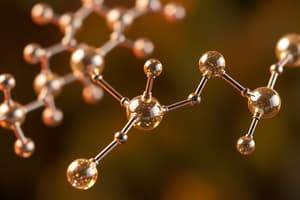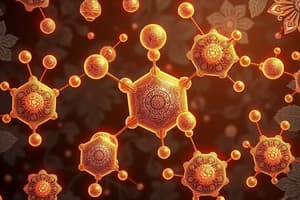Podcast
Questions and Answers
Which property of water contributes to its ability to moderate temperature changes within organisms and environments?
Which property of water contributes to its ability to moderate temperature changes within organisms and environments?
- Solvent properties
- Lower density as a solid
- High heat capacity (correct)
- Cohesion and adhesion
Hydrolysis is the process where monomers are linked together by removing water.
Hydrolysis is the process where monomers are linked together by removing water.
False (B)
Describe the significance of the R-group in the tertiary structure of a protein.
Describe the significance of the R-group in the tertiary structure of a protein.
The R-group dictates the overall three-dimensional folding of the protein, which is crucial for its function.
The cell membrane, which is composed of a ______ bilayer, regulates the passage of substances into and out of the cell.
The cell membrane, which is composed of a ______ bilayer, regulates the passage of substances into and out of the cell.
Match the following levels of protein structure with their descriptions:
Match the following levels of protein structure with their descriptions:
Which of the following best explains the endosymbiotic theory regarding the origin of certain organelles?
Which of the following best explains the endosymbiotic theory regarding the origin of certain organelles?
Saturated fats contain at least one carbon-carbon double bond in their hydrocarbon chains.
Saturated fats contain at least one carbon-carbon double bond in their hydrocarbon chains.
Describe how denaturation affects the function of a protein and list two factors that can cause denaturation.
Describe how denaturation affects the function of a protein and list two factors that can cause denaturation.
Enzymes catalyze biochemical reactions by lowering the ______ energy required for the reaction to proceed.
Enzymes catalyze biochemical reactions by lowering the ______ energy required for the reaction to proceed.
Match the following carbohydrate types with their examples:
Match the following carbohydrate types with their examples:
Which of the following is a primary function of the Golgi apparatus?
Which of the following is a primary function of the Golgi apparatus?
Active transport moves molecules across the cell membrane down their concentration gradient without the need for energy.
Active transport moves molecules across the cell membrane down their concentration gradient without the need for energy.
Explain the role of cohesion and adhesion in water transport in plants.
Explain the role of cohesion and adhesion in water transport in plants.
The ______ endoplasmic reticulum is primarily involved in lipid synthesis and detoxification processes.
The ______ endoplasmic reticulum is primarily involved in lipid synthesis and detoxification processes.
Match the following lipids with their primary function:
Match the following lipids with their primary function:
Flashcards
Matter & Atoms
Matter & Atoms
Matter has mass and occupies space; atoms are composed of protons, neutrons, and electrons.
Covalent Bonds
Covalent Bonds
Atoms share electrons to form molecules (e.g., H2O).
Ionic Bonds
Ionic Bonds
Attraction between oppositely charged ions (e.g., NaCl).
Hydrogen Bonds
Hydrogen Bonds
Signup and view all the flashcards
Proteins
Proteins
Signup and view all the flashcards
Primary structure of a protein
Primary structure of a protein
Signup and view all the flashcards
Secondary structure of a protein
Secondary structure of a protein
Signup and view all the flashcards
Tertiary structure of a protein
Tertiary structure of a protein
Signup and view all the flashcards
Quaternary structure of a protein
Quaternary structure of a protein
Signup and view all the flashcards
Dehydration Synthesis
Dehydration Synthesis
Signup and view all the flashcards
Hydrolysis
Hydrolysis
Signup and view all the flashcards
Atom
Atom
Signup and view all the flashcards
Compound
Compound
Signup and view all the flashcards
Hydrophilic
Hydrophilic
Signup and view all the flashcards
Hydrophobic
Hydrophobic
Signup and view all the flashcards
Study Notes
Matter & Atoms
- Matter occupies space and has mass
- Atoms are composed of protons, neutrons, and electrons
Chemical Bonding
- Covalent bonds involve atoms sharing electrons, exemplified by H₂O
- Ionic bonds are attractions between oppositely charged ions, exemplified by NaCl
- Hydrogen bonds are weak attractions between polar molecules, exemplified by H₂O
Water's Unique Properties
- Water demonstrates cohesion and adhesion
- Water has a high heat capacity
- Water exhibits solvent properties
- Ice floats due to its lower density as a solid
Organic Molecules
- Carbon-based molecules are critical for life
- Functional groups influence a molecule's solubility and function
Amino Acids & Peptides
- Proteins consist of amino acid polymers linked by peptide bonds
Levels of Protein Structure
- Primary structure is the amino acid sequence
- Secondary structure includes α-helices and β-sheets
- Tertiary structure involves 3D folding due to R-group interactions
- Quaternary structure involves multiple polypeptide chains
Protein Functions
- Enzymes accelerate reactions
- Structural proteins like collagen and keratin provide support
- Transport proteins, such as hemoglobin, carry substances
- Hormones like insulin act as chemical messengers
- Immune proteins, such as antibodies, defend against foreign invaders
Denaturation & Misfolded Proteins
- Denaturation results from heat, pH changes, or mutations
- Misfolded proteins are associated with diseases like Alzheimer's and sickle-cell anemia
Carbohydrates
- Monosaccharides are simple sugars like glucose and fructose
- Disaccharides consist of two sugars linked by glycosidic bonds, such as sucrose and lactose
- Polysaccharides include starch (plant energy storage), glycogen (animal energy storage), cellulose (plant structure), and chitin (fungal cell walls, insect exoskeletons)
Lipids
- Triglycerides consist of glycerol plus three fatty acids and store energy
- Phospholipids form cell membrane structures with a hydrophilic head and hydrophobic tail
- Steroids, including hormones like testosterone and estrogen, and cholesterol
Macromolecule Synthesis & Breakdown
- Dehydration synthesis links monomers by removing water
- Hydrolysis breaks down polymers into monomers by adding water
Properties of Life
- Order, reproduction, growth, energy processing, regulation, response to environment, and adaptation
Biological Organization
- Molecule → Organelle → Cell → Tissue → Organ → Organ System → Organism → Population → Community → Ecosystem → Biosphere
Cell Theory
- All living things consist of cells
- Cells arise from pre-existing cells
- Cells are the basic unit of life
Prokaryotic vs. Eukaryotic Cells
- Prokaryotic cells lack a nucleus and membrane-bound organelles
- Eukaryotic cells possess both a nucleus and membrane-bound organelles
Cell Structures Found in All Cells
- Plasma membrane, cytoplasm, DNA, and ribosomes are found in all cells
Differences Between Plant & Animal Cells
- Plant cells have a cell wall, central vacuole, and chloroplasts, while animal cells do not
Cell Organelles & Their Functions
- Compartmentalization allows multitasking, separation of reactions, and concentration of reactants
- Free ribosomes make cytoplasmic proteins
- Bound ribosomes make membrane/export proteins
Endoplasmic Reticulum (ER)
- Rough ER synthesizes proteins for secretion/membrane insertion
- Smooth ER synthesizes lipids, detoxifies, and stores Ca²⁺
Golgi Apparatus
- Modifies, sorts, and ships proteins
Lysosomes
- Breaks down waste and cellular debris
Mitochondria & Chloroplasts
- Mitochondria perform cellular respiration
- Chloroplasts conduct photosynthesis
- Both convert energy
Endosymbiotic Theory
- Mitochondria and chloroplasts originated from ancient bacteria
Plasma Membrane Functions
- The plasma membrane serves as a limiting boundary, facilitates transport, identification, communication, and attachment
Fluid Mosaic Model
- The plasma membrane comprises phospholipids, proteins, cholesterol, and carbohydrates
Transport Mechanisms
- Passive transport doesn't require energy (diffusion, osmosis, facilitated diffusion)
- Active Transport requires ATP (e.g., sodium-potassium pump)
- Bulk transport includes endocytosis (phagocytosis, pinocytosis, receptor-mediated) and exocytosis
Cell Signaling & Communication
- Receptor proteins bind signaling molecules
- Signal transduction pathways relay messages
- Glycoproteins act as cellular ID tags
Basic Chemistry & Molecular Structure
- Atom: The smallest unit of matter retaining an element's properties
- Matter: Anything that occupies space and has mass
- Element: A substance composed of one type of atom
- Molecule: Two or more atoms covalently bonded
- Compound: A substance made of two or more different elements
- Polar: A molecule with uneven charge distribution
- Hydrophilic: Water-attracting molecules
- Hydrophobic: Water-repelling molecules
Organic Molecules & Reactions
- Monomer: Small molecular unit forming polymers
- Polymer: Large molecules made of repeating monomers
- Dehydration Synthesis: Removes water to bond monomers
- Hydrolysis: Adds water to break polymers into monomers
- Denaturation: Loss of a protein's structure due to environmental changes
Cell Structure & Function
- Prokaryote vs. Eukaryote: Prokaryotes lack a nucleus and membrane-bound organelles, eukaryotes have them
- Differentiation: Cells develop specialized functions
- Passive Transport: Movement of molecules without energy
- Active Transport: Energy-required movement of molecules
Four Main Organic Molecules
- Carbohydrates are composed of monosaccharides (C, H, O) and function in energy storage (e.g., glucose, starch)
- Proteins are composed of amino acids (C, H, O, N, S) and provide structure and enzymatic functions (e.g., hemoglobin, enzymes)
- Lipids are composed of fatty acids and glycerol (C, H, O) and function in energy storage and membrane structure (e.g., fats, oils)
- Nucleic Acids are composed of nucleotides (C, H, O, N, P) and function in genetic information storage (e.g., DNA, RNA)
Protein Structure
- Primary: Amino acid sequence
- Secondary: Hydrogen bonds form α-helices and β-sheets
- Tertiary: 3D folding due to R-group interactions
- Quaternary: Multiple polypeptide chains combine
Types of Bonds in Biomolecules
- Peptide bonds in proteins
- Glycosidic bonds in carbohydrates
- Ester bonds in lipids
- Phosphodiester bonds in nucleic acids
Carbohydrates & Lipids
- Polysaccharides include starch (plants), glycogen (animals), cellulose (plant structure), and chitin (fungal walls)
Saturated vs. Unsaturated Fats
- Saturated fats are solid at room temperature
- Unsaturated fats are liquid at room temperature
Trans Fats
- Artificially created through hydrogenation
- Are harmful to health
Cell Theory
- All living things consist of cells
- Cells are the basic units of life
- All cells come from pre-existing cells
Properties of Life
- Organization, metabolism, homeostasis, growth, reproduction, response to stimuli, adaptation
Cell Components & Their Functions
- Nucleus: Stores genetic material
- Mitochondria: Energy production (ATP)
- Ribosomes: Protein synthesis
- Endoplasmic Reticulum: Protein (rough ER) & lipid (smooth ER) production
- Golgi Apparatus: Modifies and packages proteins
- Lysosomes: Digestive enzymes
- Plasma Membrane: Regulates transport in/out of the cell
Differences in Cell Types
- Prokaryotic vs. Eukaryotic Cells: Presence of a nucleus and organelles in eukaryotes
- Plant vs. Animal Cells: Plant cells have cell walls, chloroplasts, and central vacuoles
Studying That Suits You
Use AI to generate personalized quizzes and flashcards to suit your learning preferences.




